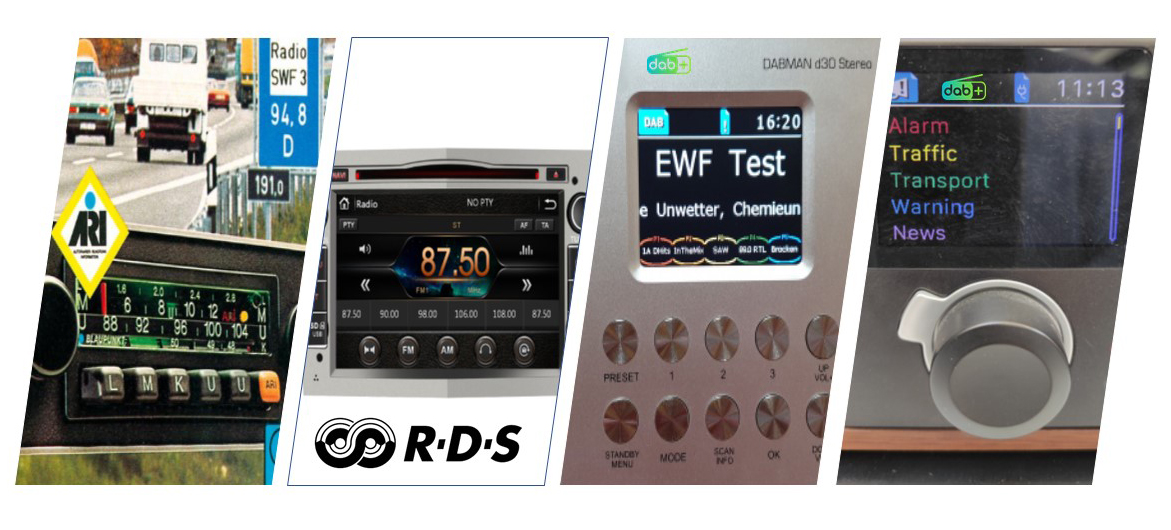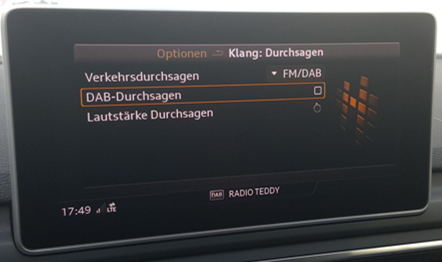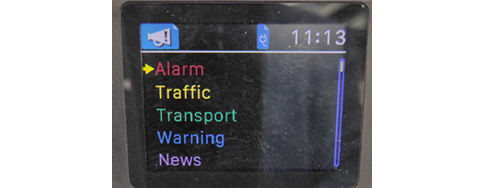Radio announcement
The basic idea of automated radio announcements is not completely new. “Autofahrer Rundfunk Information” (ARI) already existed in FM broadcasting since the 1970s followed by RDS traffic announcement. With DAB technology, the announcement feature was expanded again. For example, the new service for population warning in DAB (Emergency Warning Service EWS) is also based on this feature. In the context of an increased individualised listening behaviour, the potential of DAB announcements is now to be investigated in a larger context.

DAB announcements
In addition to traffic announcements, the DAB standard supports 10 further announcement types (see below). The “Announcement Support” function signals for which types and for which programmes the announcements are supported. Announcement Switching” is used to trigger a specific announcement in the radio device. “Announcement Support” and “Announcement Switching” are transmitted in the Fast Information Channel (FIC) of a DAB multiplex.
All DAB car radios naturally support traffic announcements. Some DAB radios already support the categories “Warning” and “Alarm”. Still few DAB radios support all announcement types. Within the framework of the project, an evaluation of receiver devices and an exchange of information with the device manufacturers is therefore important.
In the project, an info channel is provided which includes all sequentially announcements. The announcement switching is sent out time-synchronously to the audio of the respective announcement. Relevant aspects here are:
- Proportions of the relevant thematic sections and announcement types
- Length of announcements
- Frequency of repetitions and updates
- Sequence of thematic sections in relation to each other


| Announcement type | Description |
| Road traffic flash | Information about traffic conditions |
| Transport flash | Information about public transport |
| Warning service | Information and warnnings about disruptions, problems and dangers |
| Alarm | Warning with highest priority are handled on ensemble level for all programmes and are not part of the project |
| News flash | News |
| Area weather flash | Weather information |
| Event announcement | Major events (public, commercial, cultural) |
| Special event | Unplanned events |
| Programme information | Programme information |
| Sport report | Sport information and events |
| Financial report | News on finance and stock exchange |
Speech synthesis
For the generation of the info channel, speech synthesis is partly used combined with audio elements from human speakers. This involves conceptual and technical challenges that will be investigated within the framework of the project. In addition to the technical feasibility, the listening experience and the listeners’ acceptance of the chosen implementation will also be considered.
The aim of the project is to test the modern possibilities of computer-generated speech as a basis for the generation of audio programmes and to evaluate them in the context of the demonstration for programme providers.
IP-based contribution
The contribution of the signals from the service multiplexer to the ensemble multiplexer is planned via non-dedicated lines, but on the basis of simple internet access (e.g. DSL).
So far, such contributions options have hardly been used, but could represent greater flexibility and a possible cost saving for programme providers.
Cloudbased virtualization of the playout and the service multiplexer
The playout systems and the service multiplexer for this project will be realised virtualised in the cloud. Real hardware, e.g. for sound cards, will be avoided. The feasibility and the modern flexibility options will be tested with which aspects of operation can be outsourced to cloud service providers.
Since many programme providers are dominated by the use of real hardware in the studio complex for playout, cloud technologies will be examined in a realistic scenario and thus made more accessible to programme providers.
Both the technical implementation identified and tested in the project and the practically verified cost structure can be helpful for future decisions by programme providers.
For transmitter network operation, important insights can arise regarding the operation of virtualised multiplexers in cloud environments. Up to now, the direct use and operation of real hardware components has dominated here.